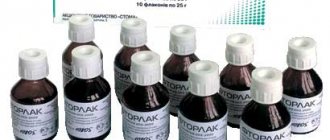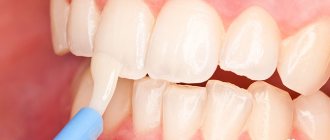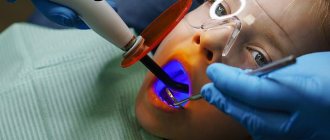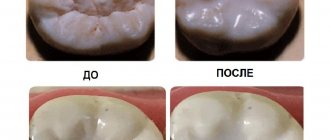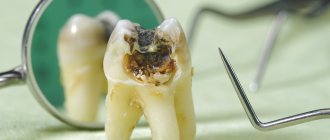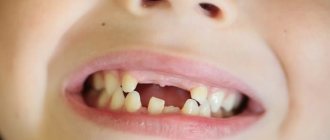Fissures are grooves on the surface of the chewing teeth. The problem is that they contain food residues, which are quite difficult to completely remove at home. As a result, the pits and grooves expand, which leads to the formation of a special type of caries - fissure caries.
To avoid such problems, you can perform “sealing” or sealing of the fissures. This procedure serves as an effective method of preventing caries, especially in children. For detailed information, make an appointment with our specialists.
In what cases is fissure sealing prescribed and why?
To prevent premature tooth decay in the fissure area, dentists recommend sealing. This method allows you to reliably close vulnerable areas, thereby ensuring their protection from the effects of bacteria. Thus, the enamel in the grooves has time to mature and strengthen, after which it becomes less susceptible to caries.
It is important to remember that the first fissure lesions can occur immediately after the eruption of permanent teeth. If their enamel is not strong enough, caries may appear during the first year of tooth growth. Therefore, it is better not to delay sealing.
Clinical methods of prevention
Once every 3-6 months, a preventive examination of the child by a dentist should be carried out so that incipient diseases are promptly detected and treated. Methods for preventing caries in children, used in a dental clinic:
- fluoridation and mineralization - coating of teeth with special solutions containing mineral components;
- sealing fissures - filling them with special material to protect against caries;
- professional oral hygiene.
Every pediatric dentist at the Natadent clinic is not just a specialist with a capital letter, but also a good psychologist. The child, involved in the examination and treatment process, will have a pleasant time in the clinic.
Dental fissure sealing – what is it?
Fissure sealing is a very simple and painless procedure. It consists of applying a certain substance to the side tooth, which reliably covers the grooves and protects them from the harmful effects of bacteria.
It often takes no more than 5 minutes to seal one tooth. In this case, the patient does not feel any discomfort. The effect of the procedure lasts for five or more years. As practice shows, patients who have undergone sealing are much less likely to have problems with the appearance of caries on fissures, even after 10-20 or more years.
Fluoridation of teeth
The health of teeth depends on the condition of the enamel, and to ensure its good condition, the body must have a sufficient amount of calcium and fluoride. Strengthening tooth enamel with preparations containing fluoride is carried out for the purpose of:
- increasing the resistance of enamel to acidic environments;
- slowing down the development of bacteria and their ability to produce acid;
- prevention of caries development on the crown;
- eliminating hypersensitivity to hot and cold foods.
The essence of the procedure for fluoridation of teeth in children is that a composition with a high content of fluoride ions is applied to the enamel of milk and newly emerging permanent teeth. It is important to understand that this method is used to prevent caries, not to treat it. Therefore, it is important to cure tooth decay before fluoridation.
When is it optimal to carry out preventive fluoridation of teeth in children:
- immediately after the eruption of baby teeth;
- annually after a preventive examination by a specialist;
- during the process of changing teeth to strengthen their enamel;
- in adolescence, when the structure of saliva changes as a result of hormonal changes in the body;
- before installing the bracket system and after removing it.
The preventive procedure can be carried out for children from 1.5-2 years old with a regularity determined by the dentist.
How is fluoridation carried out?
An important condition for strengthening teeth with fluoride is preliminary cleaning of plaque. Then simple or deep fluoridation is carried out:
- the teeth are coated with a fluoride-containing solution, which is applied with a special brush;
- The drug is dried with a special lamp or warm air.
To achieve maximum effect, it is recommended to repeat the dental fluoridation procedure once a year. If diseases of baby teeth are not dealt with, their early loss can lead to problems with bite and the need for orthodontic treatment.
Modern methods of carrying out the procedure
The technique for sealing fissures is quite simple. If all the necessary materials are available, any dentist can perform it. However, depending on the condition of the teeth, the procedure algorithm may be different.
Invasive sealing
In cases where the fissures of the tooth are very narrow or deep, or caries has already begun to develop in them or nearby, the doctor carries out invasive sealing. It begins with sanding, which allows access to the entire surface of the fissures for thorough cleaning and coating with sealant. Also, shallow carious lesions (up to 2 mm) are removed from the fissure.
If the fissure lesions are more serious and the caries has spread to large areas, the doctor carries out standard treatment before sealing. Only after this can he begin to seal the fissures. This is done to prevent the possibility of tooth decay developing under the hardened material.
Non-invasive technique
A non-invasive procedure is carried out when the tooth is completely healthy and its fissures do not even have superficial lesions. In this case, they are simply cleaned well, disinfected and a sealant is applied.
Methods for filling children's teeth against caries
There are different ways to seal baby and permanent teeth. In the capital's dentistry they offer:
- Non-invasive sealing - the procedure is carried out without compromising the integrity and structure of the tooth. The method is suitable for healthy teeth with a wide distance between the cusps on the crown. The doctor sequentially applies the compounds, closing and protecting the cavities.
- Invasive sealing - the doctor processes the enamel for better access to hidden areas on the surface of the molar in the presence of narrow and deep fissures. The procedure is also indicated if it is necessary to treat caries.
Dolotova Marina
Experience shows that sealing fissures reduces the risk of developing caries several times. This can be seen if we observe patients with a similar enamel structure and attitude towards dentistry. Children with sealed fissures keep their teeth intact and healthy for a long time.
Features of using the technique for children and adults
Typically, fissure sealing is carried out in childhood, when permanent teeth are just beginning to grow. This can significantly reduce the likelihood of developing caries in the next 5-10 or even more years. The optimal time for the first procedure is the age of 6-7 years, when the first molars finish erupting. The next procedure can be performed as early as 8-9 years. It is during this period that the first permanent premolars erupt. The third stage is the age of 12-13 years, when the second permanent molars grow, which means the completion of the formation of the children's permanent dentition.
However, in certain cases, fissure sealing may also be recommended for adults. Despite the fact that the enamel in these areas of the tooth has already been formed, for a number of reasons it can become depleted, wear out, etc. If this happens, and the patient is worried about an increased likelihood of developing caries, he can resort to a fissure sealing procedure at any age.
Arguments for and against fissure sealing in childhood
The attitude towards sealing among doctors and patients is overwhelmingly positive. This procedure is carried out quickly and does not cause any discomfort, so even the youngest visitors to the dental office will not be afraid to perform it.
However, it is important to remember that the technology for carrying it out has a clearly established algorithm. And if an inexperienced doctor does not follow it, this is fraught with deterioration in the condition of the teeth - the beginning of the development of caries under the hardened sealant. Due to the fact that the surface of the fissures will become closed after the procedure, this process can easily be missed.
Treatment of baby teeth against caries: indications
Typically, fissure sealing is carried out at the request of the parents. But sometimes dentists recommend the procedure, since sealing fissures reduces the risk of developing caries in milk and permanent teeth. The indications are:
- Young age of the patient. The enamel of newly erupted teeth has a thin layer. It is not sufficiently saturated with fluorine and calcium and is susceptible to destruction.
- Pathologically thin enamel. Sometimes the structure of tooth enamel does not change over time - it remains thin and susceptible to microorganisms.
- Curvy and narrow grooves on the teeth. The complex shape makes daily high-quality teeth cleaning impossible.
- Malocclusion and abnormal position of molars and premolars.
- Insufficient oral hygiene.
- Primary signs of enamel demineralization are stains on the tooth surface and superficial caries.
Among the contraindications:
- Carious lesions - sealing is allowed after dental treatment.
- Wide and open fissures - accessible for everyday high-quality cleaning with toothpaste.
- Allergy to sealant coating - instead of sealing, enamel silvering, remineralization, and fluoridation are available.
- Heavy salivation.
- Long-term eruption of a baby or permanent tooth – more than 4 years ago.
Materials for fissure sealing
The sealing procedure is carried out using liquid flowable materials called sealants. They quickly spread over the surface of the teeth in the fissure area, filling all the smallest recesses. They contain fluorine, which provides additional strengthening and nutrition to the enamel during the sealing period. Sealants belong to the category of light-curing materials, due to which, after application, they are able to harden within 40 seconds under the influence of a special lamp.
The color of the fissure sealant can be completely different. Teens and adults can choose a clear material or one of the white ones that will best match the shade of the surface of the teeth. For small children, multi-colored options are provided - pink, blue, etc.
Fissure sealing technique
Sealing is carried out according to a certain algorithm:
- first, the doctor thoroughly cleans the tooth surface using fluoride-free paste;
- Next, the fissure is treated with an antiseptic and cotton rolls are installed;
- for better disinfection, the tooth is treated with a special acid, which is subsequently washed off;
- After thoroughly drying the fissure, sealant is applied;
- it is fixed using a lamp;
- the excess is sanded off;
- the surface is coated with a special varnish for greater fixation.
If all steps are carried out correctly, the tooth will remain hermetically sealed for 4-5 years. After this, if necessary, the procedure can be repeated.
What are fissures?
Fissures are natural grooves and grooves located on the chewing surface of the teeth between the cusps. The shape and size of fissures, as well as their location, make it difficult to brush teeth, and accordingly, food debris can get stuck in these places, contributing to the development of pathogenic bacteria. In addition, the layer of tooth enamel in these areas is quite thin, which also contributes to the development of caries.
There are 4 types of fissure structure:
- Funnel-shaped (fluted). Shallow and fairly open mouths, smooth sloping walls with dense enamel. This shape promotes natural cleansing of fissures and facilitates their mechanical cleaning. In funnel-shaped fissures, a process of natural sealing with mineralized deposits often occurs. Caries occurs least often in them.
- Cone-shaped. The walls are located quite close, forming a cone at the mouth that is difficult to access for mechanical cleaning. Fluid is retained in such fissures, causing the enamel to be poorly mineralized, remaining porous and vulnerable to bacteria. To avoid caries, very thorough teeth cleaning is necessary.
- Flask-shaped or teardrop-shaped. The teardrop shape of the vaults makes self-cleaning impossible and makes mechanical cleaning extremely difficult. Liquid and food debris accumulate at the bases of the fissures, which ultimately often leads to caries.
- Polypoid. The shape resembles a teardrop, the walls are uneven, with protrusions. This is the type of fissure most susceptible to caries.
Indications and restrictions for the procedure
The main indication for the procedure is the completion of the eruption of permanent teeth. Since fissure sealing is one of the most effective methods of caries prevention, you should not delay it. If this time has been missed, but the process of damage has not yet begun on the teeth, fissure sealing can be done at any other age.
In addition, it is important to pay attention to the condition of the surface of molars and premolars. If pigment spots or small depressions begin to appear in the area of their fissures, this is a direct indication for the procedure.
As for restrictions, there are not many of them. The main one is severe damage to teeth by caries. Also, the procedure may be refused if the patient has allergic reactions to certain materials used.
Preventing dental problems at home
Rules for the prevention of caries at home, if followed, children will grow up with healthy and strong teeth:
- brush at least twice a day, use dental floss;
- rinse the mouth with fluoride-containing solutions;
- choose toothpastes containing calcium and fluoride;
- buy healthy foods for children, eat solid vegetables and fruits;
- try not to procrastinate with such childhood habits as sucking pacifiers and bottles;
- do not allow biting nails and various hard objects;
- normalize the bite;
- promptly treat respiratory diseases.
It is very important that the child understands the importance of prevention and daily oral hygiene procedures as early as possible.
Cost of fissure sealing
Since the procedure is non-invasive or minimally invasive and takes no more than a few minutes, the cost will also be low. Typically, you need to pay 2-3 times less for sealing one fissure than for treatment in the presence of caries.
However, the cost of the procedure may vary depending on the characteristics of the materials used, as well as the condition of the dentition. Therefore, the price must be clarified in each specific case.
The iOrtho clinic network provides high-quality services for correcting malocclusion with Invisalign aligners, sign up for a consultation now!
Reviews
Practice shows that timely prevention is the most effective way to reduce the incidence of dental diseases. This is evidenced by the reviews of our patients.
Thank you for choosing Natadent clinic and coming back to us again.
LEAVE FEEDBACK
